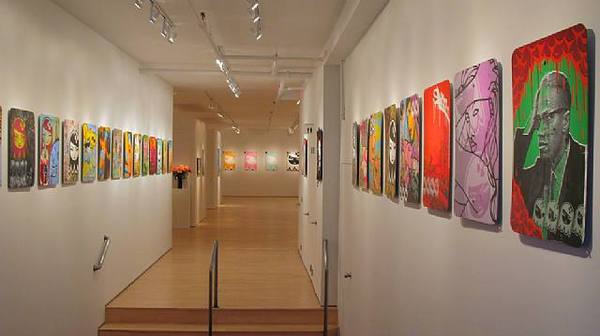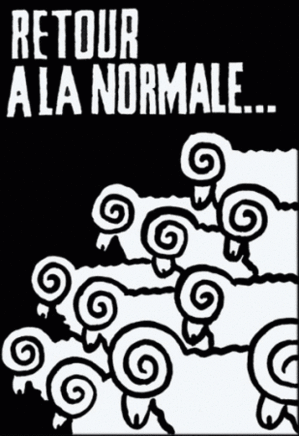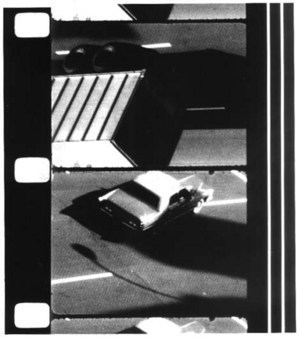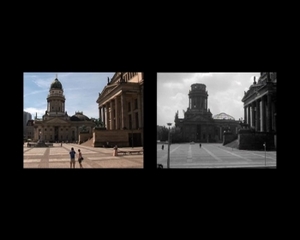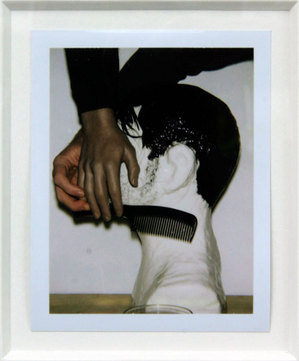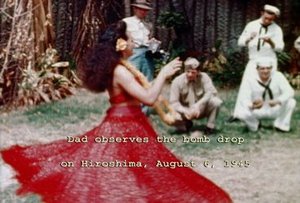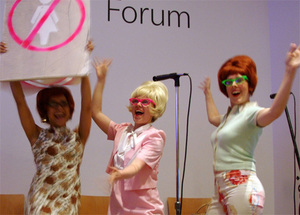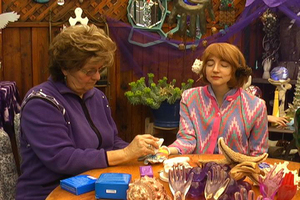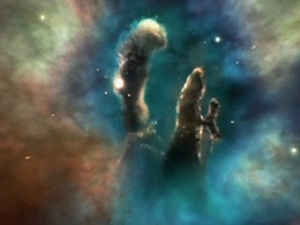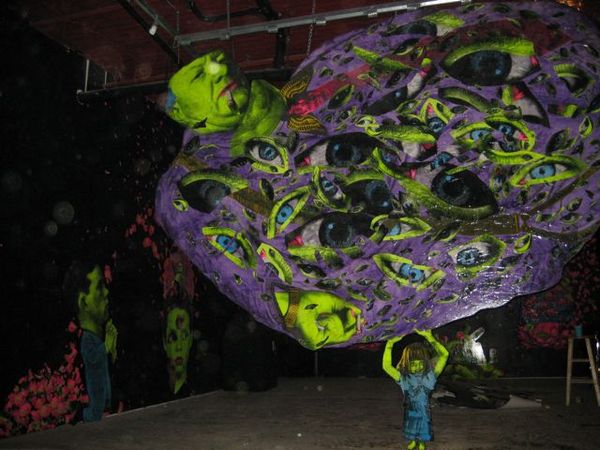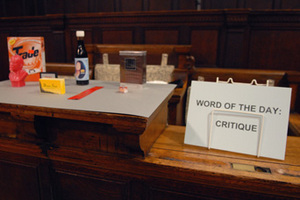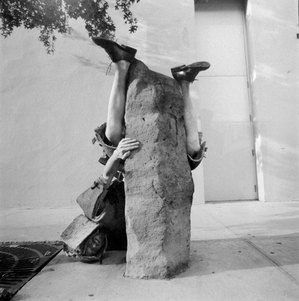This is an archive of the ArtCat Zine, 2007-2009. Please visit our new project, IDIOM.
May 2008
Street Language
Darkcloud & Matt Siren
Woodward Gallery - 133 Eldridge Street New York, NY
May 10 - June 28, 2008
Sign Language
Woodward Gallery - 133 Eldridge Street New York, NY
May 10 - June 28, 2008
The two simultaneous shows at the Lower East Side's Woodward Gallery are a complicated affair. One tagged — pardon the pun — as Street Language is by two prominent New York street artists, Matt Siren and Darkcloud. The other, titled Sign language, greets visitors to the gallery before they proceed to the larger two-person show.
"Sign Language" is comprised of small metal signs created by a dream list of street art brands, including Phalllic Memory, Celso, Vor138, Keely, Deo, xinagrafx, AVone and 2esae. These "Untitled" mash-ups juggle various styles (or brands) to produce exciting, fun and engaging panels. When Matt Siren layers his thick lines over top of The Lovely Brenda's pin up girls, there's a dialogue — each panel is like a paragraph in a larger story. The street artists vie for attention like advertisers in the city.
If the individual pieces are interesting, the show does little more than try to blatantly market aspects of a scene that doesn't really thrive in a petri dish (or a conventional art gallery). This exhibition highlights the continuing problem street art faces as it responds to growing popularity and its practitioners try to cash in on their burgeoning fame. The show does little to address the urban lexicon and some of its volatile energy.
The gallery press release tries hard to establish a relevance for what we're seeing: "Connected through the rapid waves of text messaging, blogs, and websites these urban artists are now able to connect internationally with their peers creating a shifting social network. Their organized approach to a self-guided movement, so prominent in user-generated wiki-culture, is mirrored in each artist’s unique attempt to edit the urban landscape."
The problem is that removed from the city, these sanctioned works don't edit as much as decorate. Robbed of their "natural" context they look design-y. That's not to say they aren't good, but their success is in spite of the gallery context. The works themselves are small and suffer from the choke hold of their diminutive size.
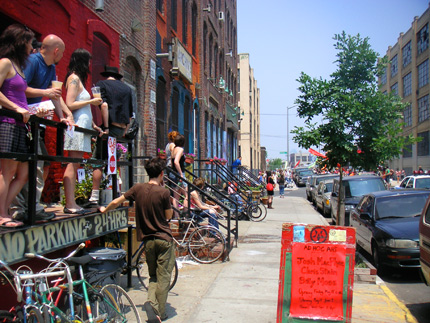
Bushwick Open Studios & Arts Festival
6 June - 8 June 2008
Various Locations
BOS Preview & Sample Sale
7:30 - 10:30pm (open bar from 7:30 - 8:30pm)
Friday 30 May 2008
Lumenhouse - 47 beaver Street Brooklyn, NY
The periphery of commercial art exhibition and production sites in this city is a constantly shifting front. Studio spaces, for instance, of artists both emerging and established dot the heavily polluted Gowanus canal on both its sides. Studio occupants catch the lunch hour takeout drift from the South Slope, while long-term development plans are underway to build a 68,000 square foot Whole Foods near the intersection of Third Avenue and Third Street. Industry City meanwhile, an industrial complex in Sunset Park, is now renting spaces to artists and developing arts organizations for a kind of tempered integration of cultural workers into the declining but still active industrial sector. Industry City developers have taken note of the wild, market-driven development cycles of neighborhoods like Williamsburg and DUMBO, the former of which is being intensely reimagined on recent subway ads the city over as the latest fledgling, luxury and culturally oriented neighborhood.
Even changes such as these however might not preclude us from suggesting that there has remained, for some years now, a kind of gravitational center for this periphery in Bushwick – at least here in North Brooklyn. Intrepid would-be gallery owners and artists seem to open new venues here each year, while a few older exhibitors calcify their rightful position in the neighborhood with strong programing. The tenor of many such programs seems more conventional than vanguard, with group and solo shows often hung that could easily be transplanted to a Williamsburg gallery without much modification (and to Chelsea perhaps with some.) Rather than launching provocations at either patrons or peer organizations, many of these galleries and spaces seem instead focused on developing interesting, ongoing programing and forging new entry paths to commercial subsistence for both themselves and the artists with which they work.
The dispersed Bushwick arts community manifests next weekend with a 3-day "self-organized art festival where anyone and everyone in the community is welcome to participate by presenting art work, organizing activities or helping to produce the event." Bushwick Open Studios & Arts Festival is sponsored by local businesses, staffed by volunteers, and promises its usual diverse range of open studios, guided history walks, weekend-long group exhibitions, performances, barbecues, film and video screenings, and probably a few parties. A week before these events, however, Lumenhouse hosts a preview and sample sale event to benefit the festival. The benefit will take place tomorrow evening, from 7:30 - 10:30, will feature an open bar for the first hour, and priced to sell donated art works for the generation of funds for the festival.
AIDS/ART/WORK
9:30am - 5:30pm Friday 30 May 2008
CUNY Graduate Center - 365 5th Avenue New York, NY
Rooms 9206/9207
$30/$20 full day registration
This friday the CUNY Graduate Center hosts a single day conference entitled AIDS/ART/WORK, exploring "the pasts, presents, and futures of AIDS art, AIDS activism, and AIDS prevention, and the connections between them." The day's events will be made up of 3 panels and a final roundtable discussion. An 'AIDS Art' Movement? will examine the potential emergence of an AIDS aesthetic, or an ongoing and developing response in both aesthetic and activist realms to the AIDS crisis, how this response has changed over time, and its relationship to avant-garde, conceptual, and representational modes of art production; Art and Activism in the Age of AIDS promises a look back at the legacy of AIDS activism and art making and its trajectory from grassroots organizing to ongoing institutionalization; Collaboration -- Problems and Possibilities promises to analyze the efficacy and history of collaborative efforts in community organizing, prevention, and education campaigns for AIDS related activist work.
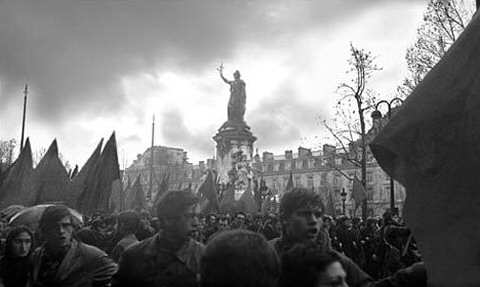
Actuellement : Regard Sur Mai 68: Photos, Musiques Et Voix
Alain Quemper
Dorothy's Gallery - 27 Rue Keller, Paris
11 April - 2 June 2008
The specter of May 1968 has been haunting us for forty years now, and it is time to put it to rest. This does not mean surrender, either to the rightist vision of a capitalism both benevolent and triumphant or to the reformist project of accommodation. Rather, it requires seeing this last gasp of revolution in the West for what it was: a failure as colossal in its implications as it was glorious in execution. "Those who make revolution halfway only dig their own graves," said the graffiti of the time, quoting Saint-Just. We — today's radicals — risk being buried alive in the grave May has dug for us.
For it was in fact a failure on many fronts. Not just in the obvious sense — the ensuing return of normalcy and a rightward electoral shift almost unprecedented in French history — but also in its successive reincarnations as a banner of the revolutionary left. The fact that May became a spectacularized image, a simulacrum, represents perhaps the greatest betrayal of its politics. Indeed, this is a central warning of Debord's Society of the Spectacle: the ideological image of the proletariat creates Bolshevism, while the ideological image of the revolutionary moment, the anarcho-syndicalist fantasy of the day of the general strike, cripples the capacity for real action. The fetishization of May does the anarchists one better. Rather than placing the magical moment of revolt in an always near but never achievable future, it relegates it to the dead and irretrievable time of the past. This facilitates the production and marketing of glossy, red-tinted souvenirs — from the works of Badiou to The Dreamers and the myriad wistful think-pieces in the left-wing dailies.
In fact, as « Regard sur mai 1968 » at Dorothy's Gallery in Paris suggests, there was never quite as total of a revolt as some imagine. The show exhibits a hundred (quite unremarkable) 1968 photographs by Alain Quemper. Of these, perhaps half a dozen depict the flag-waving revolutionary protesters we are used to seeing (and even these contain a fair number of bored or vaguely interested bystanders). Another dozen show scowling apparatchiks like Pompidou, angry at the unrest. But the rest — the overwhelming majority — show the smiling and content faces of the culture industry: actors, singers, athletes. They look as unruffled as they do in any other year; as students and workers made lofty speeches, the capitalist apparatus they represented continued blithely to chug on. In short, though the French government was briefly in danger, neither capitalism nor the State itself had anything to fear — it was a replay, not of 1789, but of 1830.
An Illustrated Lecture by P. Adams Sitney
8pm Tuesday 27 May 2008
Light Industry - 55 33rd Street 3rd Fl, Brooklyn NY
$6
P. Adams Sitney, one of this continent's most important living historians and critics of avant-garde cinema, will present an illustrated lecture this coming Tuesday in Sunset Park at Light Industry. The lecture, Eyes Upside Down, a borrowed title from Sitney's upcoming book, promises a formalist reading of three short film works, each produced about a decade or so before the next, by three decidedly American experimental filmmakers: Marie Menken, Ernie Gehr, and Stan Brakhage. Sitney will relate the three short films in the program to a type of dispersed "American aesthetic" grounded in the 19th century writings of transcendentalist and philosopher Ralph Waldo Emerson, and manifesting in the work of many cultural producers since.
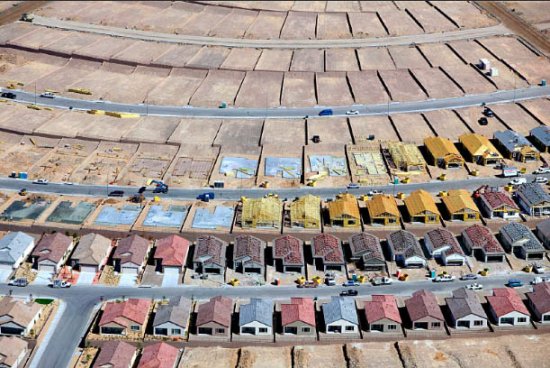
Market Forces Part I (of II): Consuming Territories
At Carriage Trade Gallery through Sunday, May 18th.
5 April - 18 May 2008
Note: Part two of this exhibition will be on view from 23 May - 9 June 2008.
Artist lofts. Think about that term for a second. When was the last time you saw an artist buy an artist loft apartment?
Walk down any block in New York, and you'll understand. No matter the developer or ad agency responsible, there it is on the scaffolding of another high rise: "Luxury artist lofts." Taking a moment to deliberate, one has to wonder if there is anything out there to purchase but luxury.
Just recently installed at Carriage Trade gallery in Soho, Market Forces Part I: Consuming Territories is a poignant commentary on how these words of commerce have been taken out of their historic confines and assigned radical new meaning. Today, artist lofts rarely house working artists, but are deliberately marketed to give the look and feel of bohemian grottoes. Add to it the redefinition of art itself – no longer a vessel of human creation or transference of beauty; there is nothing left to ponder, but only to possess. In the Market Forces exhibition, we're asked to consider if we are, or have ever been, truly free? This show serves as a cautionary tale of the present day voracious societal norm of living beyond one's means, and a harbinger of further devolution still to come.
With the completion of Manifest Destiny, growth has now turned inwards. An obliteration has occurred – yards, trees, sidewalks, being able to walk to school. Much of what was once commonplace in communities has forever vanished before our eyes. Take Alex MacLean's almost Google Earth-like aerial photographs of planned communities in various stages of development. Appearing almost like a crowded cookie sheet, or container of Marshmallow Peeps, each home is meticulously spaced just feet apart from the next. In the photo of Las Vegas, they look as if they're being built close enough for a resident to open a window and shake a neighbor's hand. An Orwellian story come to life, these planned communities give up any sense of uniqueness to the design of the home itself. There is no room for eccentricity, let alone individuality. At the same time, despite that these designs are carbon copies of each other, the cookie cutter offerings are nonetheless marketed to the buyer as "theirs to own." Viewing the desolate plots of desert land and cloned candy-shell roofs from above shows how hollow the promise rings. The continued notion of home ownership is incredibly deceitful, for no one is truly a homeowner unless they have paid every cent of the cost. MacLean is not only warning the viewer of a loss of self, but also highlights the downfall of a credit-based society lying dormant and complacent, sleeping in their 300-thread count sheets, happily sedated by their Lunesta, snoring away, all the while believing the lie. This photo in particular shows the harsh reality. The modern day lords of the land (the banks) are the real owners — a singular image of the new feudalism.
Open Studios: Amie Siegel
2pm Friday 22 May 2008
Whitney Museum of American Art - 945 Madison Ave New York, NY
$museum admission (15)
Amie Siegel will be at the Whitney this Friday to talk about her work as part of the Museum's Open Studios program, which organizes tours and talks by Biennial artists for museum visitors. Trained as a filmmaker in the American avant-garde tradition, Siegel has a diverse body of work consisting of single and multichannel works of film and video that have been previously described as conceptual, but may certainly benefit from a slight descriptive qualification here. Siegel's creative interests remain much more firmly grounded in 20th century history, film studies, psychoanalysis, Marxism, and the legacy of various social organizational projects than analytic philosophy, phenomenology, or linguistics. DDR/DDR, her feature length film in this year's Biennial program, oscillates between documentary and more stylized experimental representational strategies on the the dissolution of the German Democratic Republic and the particularities of its remnants: its peoples, narratives, and architecture.
Unframed: ACRIA Benefit Auction
5-8pm Tuesday 20 May 2008
Charles Cowles Gallery - 537 W. 24 St, New York NY
$20
Momenta Benefit 2008
Auction 5-6pm, Raffle 7-9pm
Wednesday 21 May 2008
White Columns - 320 W. 13 St (entrance on Horatio St), New York NY
$100 (entry) / $225 (entry + raffle tickets)
ACRIA, the Aids Community Research Initiative of America holds their benefit auction tonight at Chelsea's Charles Cowles Gallery featuring unframed works by Margaret Evangenline, James Nares, Jim Hodges, Joe Andoe, and others. ACRIA is a New York based, independent not-for-profit that has been working since 1991 towards the advancement of HIV/AIDS research, treatment, and education. Tickets for the auction are available at the door for $20 and include cocktails provided by Belvedere Vodka.
Tomorrow night meanwhile Brooklyn's Momenta Art, a non-profit artist-run charitable organization and exhibition site hold their thirteenth annual benefit auction and raffle at White Columns. Patrons who purchase raffle tickets to the event will gain admittance for two to the party and auction tomorrow, a guaranteed work of art from the raffle bin, and a chance to bid in the silent auction on other works by Carol Bove, Huma Bhabha, Wolfgang Tillmans, Trisha Donnelly, Rirkrit Tiravanija, Anne Collier, and others. To buy tickets please visit Momenta's website.
i've nothing to lose
nothing to gain
i'll kiss you in the rain
--from Blackout, David Bowie
Jeremy Gilbert-Rolfe
Alexander Gray Gallery - 526 West 26th Street #1019, New York NY
April 30 - June 14, 2008
At the reception for Jeremy Gilbert-Rolfe's transcendent show at Alexander Gray one of the guests kept prattling on about somebody they knew who knew David Bowie. Y'know, the typical overhear-me-please stuff that one sometimes hears at openings. But it was OK, because their random noise sent me in an appropriate direction: West Berlin, 1976.
Let me explain. I was climbing into the painting, Up, and thinking about all the ways it explores and exploits The Grid when my jabbering pals put The Thin White Duke into my head. In '76, when Bowie needed to get off the grid of a certain approach to song (and career) he went to West Berlin with Brian Eno to record two great albums, Low and "Heroes". The time signatures and melodies are never exactly where they should be, but somehow Bowie's escape from the grid makes the listener even more aware of it, not unlike the the Krautrock from which Bowie and Eno stole so liberally.
But I deviate. Obviously.
Paul Chan: The Tin Drum Trilogy
7:30 Friday 16 May 2008
The New Museum - 235 Bowery, New York NY
$8
Tonight the New Museum offers an opportunity for patrons to see the complete three-part series of Paul Chan's Tin Drum Trilogy, a collection of video works that independently pivot around three groups of people whose image or sense of agency is somehow deeply entrenched in the political narratives of early 21st century America. The regime of personalities that has ruled the nation for the past seven years is the topic of the earliest work in the series, RE:THE_OPERATION, which Chan constructs as an epistolary fiction in which the animated heads of the heads of state are presented bruised and weary from the trials of front-line warfare and transplanted in Photoshop vernacular montage onto bodies composed in vacation-style documentary photos of the often mundane everyday of military life, writing home about their difficulties, anxieties, and day-to-day life. The second work in the series, Baghdad In No Particular Order, is an experimental documentary shot in Iraq months before the initial American invasion of 2003, when Chan, along with an activist group calling itself Voices in the Wilderness, broke international sanctions to journey to Baghdad shortly before the war that would eventually destroy one of the Middle East's more secular, modern states. The artist in Baghdad naturally recorded images, of which this second video is primarily constituted. Baghdad... in its completeness taps into an experimental documentary tradition and affirms an absence -- the then still absence of war, or visible human suffering -- in the wake of all that threatened to disrupt it, and an un-imagined or un-imaginable Iraqi public, images that the artist himself, an expert animator, couldn't dream up from the continent where the obliteration of that public would commence. The final film in the series, Now Promise Now Threat, shot in the artist's second home town of Omaha, Nebraska, imagines another public: a kind of decisive, abstracted public -- the religious right of red-state America -- captured in fragments of vignettes, interviews, orations, and so on shortly following the re-election of a widely criticized president.
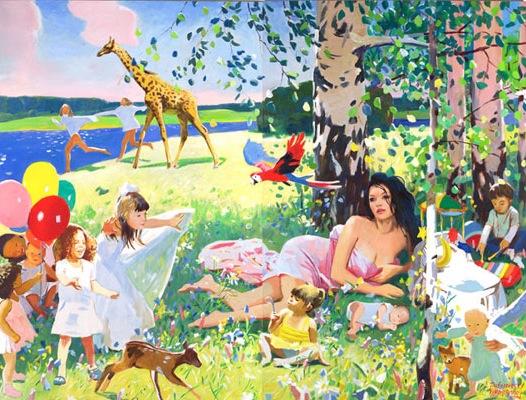
The New People Are Already Here
Vladimir Dubossarsky and Alexander Vinogradov
Deitch Projects - 76 Grand St, New York NY
Russia is a country of many contradictions. The rich live lavishly, adorned with Chanel and BMW SUVs that often come with a driver and a body guard. The poor, on the other hand, live in dire straits because the vestiges of a dead regime following the dissipation of the Soviet Union left them with nothing more than pathetic pensions that are not a far leap from Soviet bread lines and empty shelves in department stores. In fact, according to the Forbes list of the richest men in the world, number three, following Bill Gates and Warren Buffet, is the Russian mogul Roman Abramovich. Fine, he is actually number 11, but at the age of 39, his net worth is $18.2 billion. And yet the tight fists of the neo-dictators, who rule this multifarious and expansive land, seek to rid the country of criminal activity that has been so conducive to the "oligarch" status the wealthy men of business have acquired. The less fortunate masses view former president, now prime minister Putin's Czar-like persona with the same ambivalence that marks this nation; after all, while he has tacitly extinguished any potential opposing voices (read: killed off all the journalists who dare to speak any brazen truth), he has equally quelled the fires of mafia wars that raged in Russia through the 1990s. With business management and democratic politics under their belt, elite Russians have turned to art as the category of knowledge that can buy them a certain level of sophistication. In fact, Sotheby's recently shipped a collection of works to Bavrikha, a high end mall of sorts on the outskirts of Moscow, where the oligarchs buy their Gucci and their Fendi, and now, can browse the de Koonings, Hirsts and Warhols.
Leslie Thornton: Photography is Easy
6:30pm Wednesday 14 May 2008
EAI - 535 W 22 St, New York NY
Electronic Arts Intermix will screen some rarely seen films and videos tonight by artist Leslie Thornton, whose ambitious, rich works often incorporate a catalog of cross-disciplinary modalities that in the past have been influenced by the artist's interest in media theory, gender studies, linguistics, history, and so on. Thornton's 2004 video Let Me Count the Ways 10...9...8...7...6, for instance, included in this year Whitney's Biennial, presents five short segments on the narratives, historical legacy, and cultural and visual byproducts of the Hiroshima bombing — an event still taught in this country at many public high schools as an overwhelmingly favorable conclusion to the Second World War. The artist will be present tonight to lead a conversation following the screening, as well as present a new interactive video installation.
A Day of Collaborative Performance
Making it Together
12-6pm, various times and locations
The Bronx Museum - 1040 Grand Concourse, Bronx NY
This Saturday the Bronx Museum of Art hosts A Day of Collaborative Performance, a live component to Making it Together, an exhibition curated by Carey Lovelace currently installed at the museum that explores "an important chapter in recent history when women artists, inspired by the 1970s Feminist Movement, worked collectively in new ways to engage communities and address social issues." Among the various groups participating this weekend will be The Brainstormers working collaboratively with Guerrilla Girls to stage a performative protest in front of the museum addressing gender inequities in the exhibition venue at 1:30pm. At 3pm, The Waitresses will host an "Unhappy Hour" and serve drinks and snacks with price modifications based on the gender of museum patrons. Ridykeulous will collaboratively build a plaster and found-object sculpture from noon onwards to the musical accompaniment of Legends, only to destroy the work later at 5pm. A complete schedule of the day's events is available on the museum's website.
Rhizome 2008 Benefit
9pm Thursday 15 May 2008
Participant Inc - 253 Housten St, New York NY
$35+
Film-Makers Cooperative Benefit Screening
8pm Friday 16 May 2008
The Stone - Avenue C and E. 2 St, New York NY
$5
This Friday, 16 May, the Film-Makers Cooperative hosts their annual benefit screening downtown at The Stone. The Cooperative, since it's inception in 1962 by a group of some 25 New York based Filmmakers (including by now some highly visible figures like Anthology Film Archives founder Jonas Mekas, filmmakers Jack Smith, Rudy Burckhardt, and Ken Jacobs, among others), has been one of New York's primary distribution centers of avant-garde and experimental cinema. The organization has been archiving, preserving, storing, distributing, and exhibiting work that has for many years, by consequence or design, kept a distinctly separate existence from the commercial art distribution system and its attendant reserves of capital, glamour, media apparatus, and intricate social networks. Things certainly have changed since then – most art spectators with a rudimentary orientation to the international exhibition scene will today be able to prattle off countless prominent and commercially successful contemporary artists who produce, and sell, works on film and video. The Film-Makers Cooperative regardless continues its important work, affirming its no-contest film distribution policies, artist owned and operated status, regular screening programs, and legacy as one of New York's historic cultural institutions. The screening program for the evening is TBA.
Meanwhile on the preceding night, Thursday 15 May, Rhizome hosts its own annual benefit with an exciting schedule of live music and events, including the indelible performance work of artist Shana Moulton, a DJ set by MEN, live music by High Places, and more. This year the vanguard New Media organization honors Joshua Schatchter, the software engineer whose wildly popular social link aggregation system, del.icio.us, has become embedded in countless new collaborative creative practices taking form on the web. Rhizome also honors artist Lynn Hershman Leeson for a long-standing record of creative output and experimentation with new genres and media.
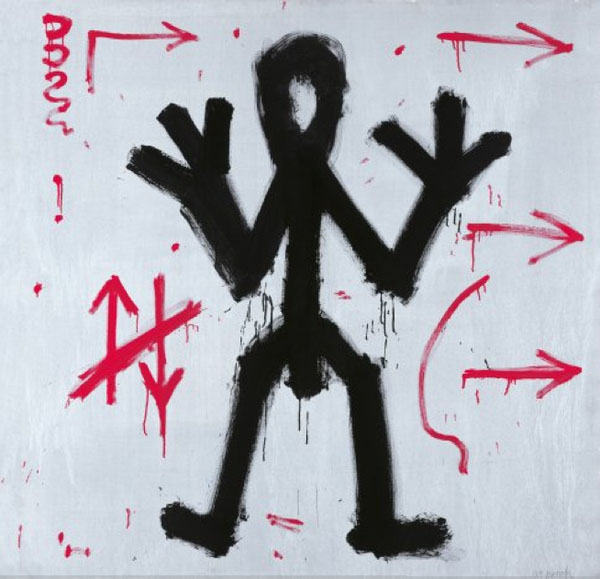
A. R. Penck
Musee d'Art moderne de la Ville de Paris
14 February – 11 May 2008
Ralf Winkler took his pseudonym, A. R. Penck, from the early twentieth-century geologist Albrecht Penck, an expert on the Ice Age. It was not an accidental choice: geology and "stored information," the artist says, have a certain affinity — and information is one of his most fundamental preoccupations. Penck is as much cyberneticist as painter. An elaborately conceived symbolic alphabet appears both directly and allegorically throughout his work, and his artistic project is constantly informed by the need to work through the implications of language, symbolic systems, communicative abstraction (thus, until the late '70s, Penck often accompanied his projects with theoretical texts).
Yet despite this very modern awareness of systems theory, his work consistently recalls the Ice Age in another way. Penck's artworks are not just vaguely primitivist: they are self-conscious evocations of the most ancient art. Penck sees his project as a "recourse to archeology," as "clearing a path through all of art history back to the cave paintings." This dialectical confrontation between the old and the new gives his painting a compelling, and unusual, pathos. The French sociologist Edgar Morin once described civilization as a passage from the problem of the caveman to the problem of the caves within man. Penck aims to attack both problems at once.
CRG Video Series: Specter
CRG Gallery – 535 W 22 St, New York NY
7pm Thursday 8 May 2008
Summer Guthery curates tonight's edition of CRG Gallery's regular one-night video programs. Specter features work by Ronnie Bass, Matthew Lutz-Kinoy, Desiree Holman, Shana Moulton, Lars Laumann, and a few others. The thematic points of of the program, "prophecy, mirroring, and shifts", foretell a good potential for starry video backdrops and New Agey costumes and sets, the like of which the roster of artists certainly wouldn't shy away from. Summer Guthery is a curator who recently launched Why + Wherefore, an online venture with Nicholas Weist and Lumi Tan.
Dirt Mansion
Judith Supine
English Kills - 114 Forrest St, Brooklyn NY
12 April - 8 June 2008
For the rest of Spring, a site-specific installation by Judith Supine will be on view at the English Kills Art Gallery in Bushwick, Brooklyn. Supine covers the walls with painted fragments of hot magenta water lilies that shimmer like fluorescent potpourri between the large green figures. This is Supine's first solo show in New York. It is another example of an artist accustomed to working on the streets entering the gallery context.
Supine presents his vibrant green figures under black light. On the day of the opening, half of the main hall was illuminated by incandescent light while the other half was under black light. The artist was so pleased by the appearance of the works under the purple bulbs that he asked the gallery to remove all the incandescent fixtures. A few did manage to remain to emphasize certain works. The black light compliments Supine's glowing color spectrum and the eerie appearance of his green figures.
The history of painters working with black lights is a modest one. Roberto Matta, to cite one example, sometimes painted under black lights but his works are never illuminated as such at MoMA. Matta's production methods fail to leave a mark on the exhibition procedure here, further asserting that in an era of extreme urban light pollution, exhibition spaces still cling to the tired model of the bright white cube. Some spaces, however take steps in a different direction: the 2008 Dark Fair at the Swiss Institute Contemporary Art in SoHo recently examined the display possibilities of candle light. Yet, in this case SI functions as an exception that proves the rule.
Artists, however, can go further than just presenting their work under a strange light. The true test is always whether unconventional illumination can tease out some quality that might otherwise be suppressed in a picture, or enhance the content that is already present. By introducing the realm of the shadow and that outlandish glow of the black light, Supine raises his work to a new level of ethereality.
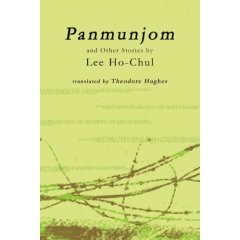
Artist Talk and Discussion, Dongducheon: A Walk to Remember, A Walk to Envision
7:30pm Thursday 8 May 2008
$museum admission (free Thursday nights)
Theodore Hughes at the New Museum
3pm Saturday 10 May 2008
$museum admission (12)
Korean studies scholar Theodore Hughes will be presenting a lecture at the New Museum this weekend as part of the Museum as Hub program. The title of the lecture, Everyday Life, Violence, and the State of Exception, makes reference to a titular concept Giorgio Agamben expounds upon in his 2005 book, referring to a state of siege or suspension of procedural codes inherent in times of massive social unrest. While this state may be most common to a time of war or revolutionary upheaval, it is becoming a more familiar condition to citizens of this Western democracy and others as acclimation to an endless, abstracted, and dispersed "war on terror" rages since 2001. Hughes will be lecturing on the complex set of relations between the United States and South Korea since the Korean War, a set of relations "marked by neocolonialism, militarism, Cold War developmentalism, sex work, and commodity fetishism." From the press release:
Paying attention to the ways in which the Museum as Hub exhibition Dongducheon: A Walk to Remember, A Walk to Envision works to unpack the allegorical gesture that has informed this constellation for much of South Korean history, Theodore Hughes examines the relationship between violence and the everyday in Dongducheon.
The A Walk to Remember... will remain on view at the Museum through 9 July, 2008. Sangdon Kim, Koh Seung Wook, Rho Jae Oon, and siren eun youg jung, the four artists comissioned by the Museum as Hub program, will also be having a conversation with Insa Art Space curator Heejin Kim on the evening Thursday 8 May, 2008.
Carey Young: Speechcraft
6:30pm Friday 9 May 2008
42 44th St New York, NY
Carey Young has, since the end of her formal training as an artist and photographer, worked professionally in various capacities in the corporate world of public speaking and relations. While Young does not insist that this professional work is a direct part of her larger creative project, it has has without question greatly influenced and informed her artistic production. Young often wears a "power suit" in her performance videos and adapts a highly stylized Euro-American corporate language to both communicate and subvert meaning and work towards creating sites of transparency from within the institutions and exhibition venues she occupies. In works like the 2001 I am a Revolutionary for instance, Young undergoes an intensive three day public speaking seminar in order to deliver a speech ending with the eponymous locution. The finished product is a short video that captures an excerpt from this training process, emphasizing the banality and instrumentalization of language that happens in an expanded commercial playing field that, like contemporary art, has all but negated its own boundaries with regards to what can be repurposed and utilized to ensure that money continues to change hands. Other works by Young originate from a more 90s variety of institutional critique, in which organizational transparency and the strategies for its manifestation are the prime in creative currency. Color Guide, a 2004 comission that the artist completed for Index Foundation on Stockholm, in one such example, filtering the light passing through one of the gallery windows with a grid of the Corbis Corporation's suggested range of colors to be depicted by their freelance stock photographers. An earlier work, Nothing Ventured, is an installation that presents exhibition visitors with a telephone and sitting arrangements where they may pick up and communicate with a non-specialist call center operator hired to represent the artist and provide basic biographical and exhibition information, as well as potentially more interpretive, analytic information if questioned. In this work the usually obscured role of the artist's exhibitor as representative is put in competition with a more emphatic, visible presence created by the artist herself.
This Thursday Carey Young will present Speechcraft, a recently completed collaborative performance with Toastmasters International, a group dedicated to the development of public speaking skills. The performance is part of Hey Hey Glossolalia, a series of free events in New York City this may curated by Mark Beasely and produced by Creative Time. The performance is described on the artist's website as follows:
Speechcraft features a meeting of the international public speaking club Toastmasters . Widely used by businesspeople as well as trainee lawyers and politicians, Toastmasters helps people from all walks of life to construct their public presence so that they look and sound like ‘leaders’. In the first commission of this piece the work was hosted by the Oxford Toastmaster club Isis Speakers.
Speechcraft is a performance work which takes a Toastmaster meeting as a readymade performative situation. The artist inserts specific subject matter for speakers to respond to by giving an impromptu speech. In this version of the work, the subject matter given to the speakers were all objects from Carey Young's studio which she personally finds inspiring.As with every Toastmaster meeting, all the resulting speeches were judged and evaluated by other Toastmaster members, as well as the audience, in a cycle of inspiration, review, and reward.
Tickets to the event are free, but may be reserved here.
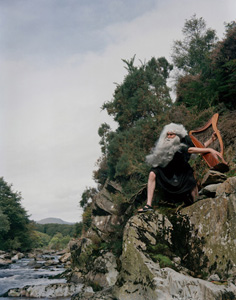
The Eroticism of Pedagogy
6-8pm Sunday 4 May 2008
Judson Memorial Church - 55 Washington Sq South, New York NY
Hey Hey Glossolalia: Exhibiting the Voice is a series of free events this May curated by Mark Beasley and sponsored by Creative Time. The month long program of events and the accompanying publication (co-produced and designed with Dexter Sinister) aspires to "express the infinite shades of the voice" with a slightly idiosyncratic group of artists, curators, writers and musicians (all the inherent cross overs implicit, of course) who will present talks and performances for the the run of the events. The Eroticism of Pedagogy, this Sunday's program, in particular comes highly recommended. The event will feature 3 performance conversations on the formal perimeters of the lecture as a structured transmission of knowledge, with a bend towards disruption; participants will include artists Ryan Gander and Bedwyr Williams, curator and writer Tirdad Zolgadhr and artist Liam Gillick, and artists Adam Pendleton and Frances Stark. The event is free, but guests may still RSVP online.
The Brucennial
6pm-10pm Thursday 1 May 2008
The Bruce High Quality Foundation - 1100 Broadway, Brooklyn NY
The Bruce High Quality Foundation last week mounted The Retrospective at Susan Inglett Gallery. Tonight the Foundation launches a second, parallel portion to their exhibition at the collective's Brooklyn site and theater. The Brucennial will feature some 90 additional participating artists and will remain on view through 1 June. A reception and a program of performance is scheduled tonight, the latter to begin at 7:30pm (sharp).
ZINE
HOME
TIPS / COMMENTS
CATEGORIES
CONTRIBUTORS
- Greg Afinogenov
- B. Blagojevic
- Adda Birnir
- Susannah Edelbaum
- Julie Fishkin
- Paddy Johnson
- Jessica Loudis
- Christopher Reiger
- Andrew Robinson
- Peter J. Russo
- Blythe Sheldon
- S.C.Squibb
- Hrag Vartanian

